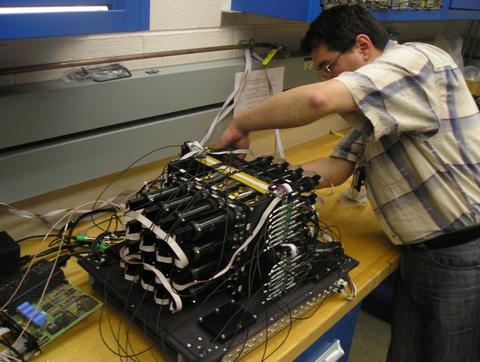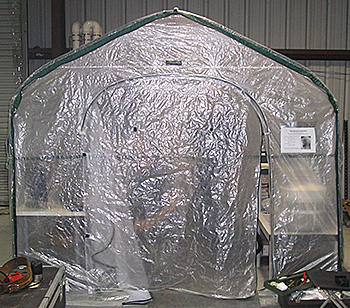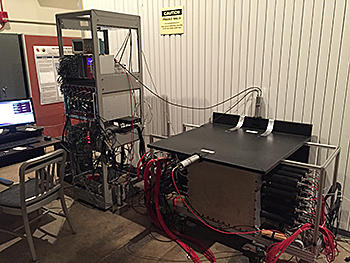Summary
We continue to work improving techniques in fast neutron detection using segmented spectrometers based on the principle of capture-gating. Our approach employs an organic scintillator to detect fast neutrons through their recoil interaction with protons in the scintillator. The neutrons that thermalize and are captured produce a signal indicating that the event was due to a neutron recoil and that the full energy of the neutron was deposited. The delayed neutron capture also serves to discriminate against uncorrelated background events. The segmentation permits reconstruction of the initial neutron energy despite the nonlinear response of the scintillator. We have constructed spectrometers using both He-3 proportional counters and Li-6 doping as capture agents in plastic and liquid organic scintillators. We discuss the operation of the spectrometers for the measurement of low levels of fast neutrons for several applications, including the detection of very low-activity neutron sources and the characterization of the flux and spectrum of fast neutrons at the Earth's surface and in the underground environment.
Description

Energetic neutrons (> 1 MeV) play a variety of important roles from dosimetry to the fundamental sciences. Fast neutrons can be an often under-appreciated but significant biological dose from accelerators and nuclear facilities, serve as a way of detecting nuclear materials, and can often yield significant and difficult to control backgrounds in low-rate experiments such as neutrino and dark matter searches. Because they are neutral particles that predominantly interact via the strong interaction, neutron detection and measurement present challenges distinct from those of charged particle and gamma detection, where there are numerous mature technologies optimized for specific-use cases that can provide exquisite energy resolution or very well determined efficiencies. This program is developing highly-segmented detectors that allow the measurement of neutron spectra over energy ranges relevant to dosimetry, nuclear non-proliferation, and cosmogenic background studies for neutrino and dark matter experiments.

Quantitative fast neutron detection and metrology presents significant challenges, particularly when spectral information is required because the interaction signal directly carrying neutron energy information is a low energy nuclear recoil. To avoid the difficulties in detecting low energy recoils, technologies often infer neutron energy indirectly through effective attenuation or thermalization and require complicated unfolding procedures and offer limited energy measurement ranges. Often such detectors are cumbersome expensive detector assemblies that are difficult to transport. On the other hand, technical approaches that use recoil information to extract incident neutron energy are complicated by the non-linear response of detection media. In terms of obtaining high energy spectral information, one can correct for this non-linear response by segmenting the detector such that neutrons typically scatter in a single segment. Such an approach greatly reduces the complexity of unfolding algorithms. Finally, integrating an appropriate neutron capture isotope into the detector can provide a unique event tag and provide powerful background rejection, allowing operation in, for example, higher gamma-flux environments.
Figure 1 shows the final assembly of a 16-channel spectrometer constructed in collaboration with Russian researchers at the Institute for Nuclear Research. The size of the 16 segments was chosen so that a fission energy fast neutron (~1 MeV) interacts on average only once in a segment, thus allowing one to correct for the nonlinear light yield, which as noted above, is the dominant cause of poor energy resolution. The detector uses a commercial liquid scintillator that we have doped with enriched Li-6 to act as the neutron capture agent.

In collaboration with the University of Maryland and Yale University, we have also constructed two larger volume detectors to use in the underground and surface environments where high efficiency is more important that energy resolution. A prototype Fast Neutron Spectrometer (FaNS-1) consisting of six He-3 proportional counters placed between six large blocks of plastic scintillator was completed and assembled at Kimballton Underground Research Facility near Blacksburg, VA, as seen in the photograph in Figure 2. It has also been used to measure fast neutron backgrounds near reactors in support of short baseline neutrino experiments and at NCNR beamlines.
Most recently, using knowledge gained from the FaNS-1 detector, we designed and constructed a second spectrometer (FaNS-2, shown in Figure 3) consisting of a larger volume of plastic scintillator and more He-3 proportional counters. This larger volume gives a greater sensitivity to the fast neutron flux and a larger dynamic range of approximately 1 MeV to 1 GeV. The detector is being used to measure the fast neutrons induced by cosmic rays at the Earth's surface and in shallow underground locations. In addition, fast neutron spectroscopy has use in understanding very high energy neutrons, such as those from accelerators and fusion reactions. Although this program is not currently active, the spectrometers still exist and could, in principle, still be used for new applications.

